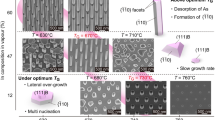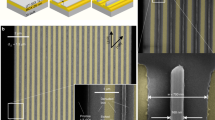Abstract
Three-dimensional integration and the combination of different material systems are central themes of electronics research. Recently, as-grown vertical one-dimensional structures have been integrated into high-density three-dimensional circuits. However, little attention has been paid to the unique structural properties of germanium nanowires obtained by epitaxial and heteroepitaxial growth on Ge(111) and Si(111) substrates1,2, despite the fact that the integration of germanium on silicon is attractive for device applications. Here, we demonstrate the lateral growth of single crystal germanium islands tens of micrometres in diameter by seeding from germanium nanowires grown on a silicon substrate. Vertically aligned high-aspect-ratio nanowires can transfer the orientation and perfection of the substrate crystal to overlying layers a micrometre or more above the substrate surface. This technique can be repeated to build multiple active device layers, a key requirement for the fabrication of densely interconnected three-dimensional integrated circuits.
This is a preview of subscription content, access via your institution
Access options
Subscribe to this journal
Receive 12 print issues and online access
$259.00 per year
only $21.58 per issue
Buy this article
- Purchase on Springer Link
- Instant access to full article PDF
Prices may be subject to local taxes which are calculated during checkout





Similar content being viewed by others
References
Adhikari, H., Marshall, A. F., Chidsey, C. E. D. & McIntyre, P. C. Germanium nanowire epitaxy: shape and orientation control. Nano Lett. 6, 318–323 (2006).
Jagannathan, H. et al. Nature of germanium nanowire heteroepitaxy on silicon substrates. J. Appl. Phys. 100, 024318 (2006).
Shang, H. et al. Electrical characterization of germanium p-channel MOSFETs. IEEE Electron. Dev. Lett. 24, 242–244 (2003).
Chui, C. O. et al. Germanium MOS capacitors incorporating ultrathin high-kappa gate dielectric. IEEE Electron. Dev. Lett. 23, 473–475 (2002).
Kim, H., Chui, C. O., Saraswat, K. C. & McIntyre, P. C. Local epitaxial growth of ZrO2 on Ge(100) substrates by atomic layer epitaxy. Appl. Phys. Lett. 83, 2647–2649 (2003).
Okyay, A. K. et al. High-efficiency metal–semiconductor–metal photodetectors on heteroepitaxially grown Ge on Si. Opt. Lett. 31, 2565–2567 (2006).
Kim, S. et al. Integrating phase-change memory cell with Ge nanowire diode for crosspoint memory-experimental demonstration and analysis. IEEE Trans. Electron. Dev. 55, 2307–2313 (2008).
Liu, Y. C., Deal, M. D. & Plummer, J. D. Rapid melt growth of germanium crystals with self-aligned microcrucibles on si substrates. J. Electrochem. Soc. 152, G688–G693 (2005).
Csepregi, L., Kennedy, E. F., Mayer, J. W. & Sigmon, T. W. Substrate-orientation dependence of epitaxial regrowth rate from Si-implanted amorphous Si. J. Appl. Phys. 49, 3906–3911 (1978).
Nakaharai, S. et al. Characterization of 7-nm-thick strained Ge-on-insulator layer fabricated by Ge-condensation technique. Appl. Phys. Lett. 83, 3516–3518 (2003).
Witte, D. J. et al. Lamellar crystallization of silicon for 3-dimensional integration. Microelectron. Eng. 84, 1186–1189 (2007).
Kodambaka, S., Tersoff, J., Reuter, M. C. & Ross, F. M. Germanium nanowire growth below the eutectic temperature. Science 316, 729–732 (2007).
Leu, P. W. et al. Oxide-encapsulated vertical germanium nanowire structures and their dc transport properties. Nanotechnology 19, 485705 (2008).
Fossum, J. G., Ortizconde, A., Shichijo, H. & Banerjee, S. K. Anomalous leakage current in LPCVD polysilicon MOSFETs. IEEE Trans. Electron. Dev. 32, 1878–1884 (1985).
Ahmed, S., Kim, D. & Shichijo, H. A comprehensive analytic model of accumulation-mode MOSFETs in polysilicon thin films. IEEE Trans. Electron. Dev. 33, 973–985 (1986).
Spaepen, F. & Turnbull, D. Kinetics of motion of crystal–melt interfaces. AIP Conf. Proc. 50, 73–83 (1979).
Xu, Q. et al. Large melting-point hysteresis of Ge nanocrystals embedded in SiO2 . Phys. Rev. Lett. 97, 155701 (2006).
Turnbull, D. & Fisher, J. C. Rate of nucleation in condensed systems. J. Chem. Phys. 17, 71–73 (1949).
Turnbull, D. Kinetics of heterogeneous nucleation. J. Chem. Phys. 18, 198–203 (1950).
Turnbull, D. & Cohen, M. H. Concerning reconstructive transformation and formation of glass. J. Chem. Phys. 29, 1049–1054 (1958).
Becker, R. & Doring, W. Kinetische behandlung der keimbildung in ubersattigten dampfen. Ann. Phys.-Berlin 24, 719–752 (1935).
Lide, D. R. CRC Handbook of Chemistry and Physics (Taylor and Francis, 2008).
Stojic, M., Babic Stojic, B. & Milivojevic, D. Influence of vacancies on the static and dynamic properties of monoatomic liquids. Phys. B: Condens. Matter 334, 274–286 (2003).
Evans, P. V., Devaud, G., Kelly, T. F. & Kim, Y.-W. Solidification of highly undercooled Si and Ge droplets. Acta Metall. Mater. 38, 719–726 (1990).
Acknowledgements
The authors thank the members of the Nanowire Facility at Stanford University, I. A. Goldthorpe, J. Ratchford, J. Woodruff, Y. Zhang and H. Adhikari for helping maintain the nanowire growth reactor, and J. McVittie and Y. Nishi for managing the facility. The authors also thank T. Brand and R. Macdonald for help in the CMP process and J. Feng for useful discussions. Funding for this work was provided by the DARPA SPAWAR 3D-IC programme, a Stanford School of Engineering Fellowship and a Stanford Graduate Fellowship.
Author information
Authors and Affiliations
Contributions
All authors discussed the results and commented on the manuscript. S.H. and P.C.M. conceived and designed the experiments, analysed the data and co-wrote the paper. S.H. and P.W.L. performed the experiments. A.F.M. contributed TEM sample preparation and analysis.
Corresponding author
Rights and permissions
About this article
Cite this article
Hu, S., Leu, P., Marshall, A. et al. Single-crystal germanium layers grown on silicon by nanowire seeding. Nature Nanotech 4, 649–653 (2009). https://doi.org/10.1038/nnano.2009.233
Received:
Accepted:
Published:
Issue Date:
DOI: https://doi.org/10.1038/nnano.2009.233
This article is cited by
-
High-electron-mobility (370 cm2/Vs) polycrystalline Ge on an insulator formed by As-doped solid-phase crystallization
Scientific Reports (2019)
-
Characterization and nanocrystalline growth of a-Ge:In/c-GaAs
Applied Physics A (2019)
-
Improving carrier mobility of polycrystalline Ge by Sn doping
Scientific Reports (2018)
-
Wafer-level and highly controllable fabricated silicon nanowire transistor arrays on (111) silicon-on-insulator (SOI) wafers for highly sensitive detection in liquid and gaseous environments
Nano Research (2018)
-
High-hole mobility polycrystalline Ge on an insulator formed by controlling precursor atomic density for solid-phase crystallization
Scientific Reports (2017)



